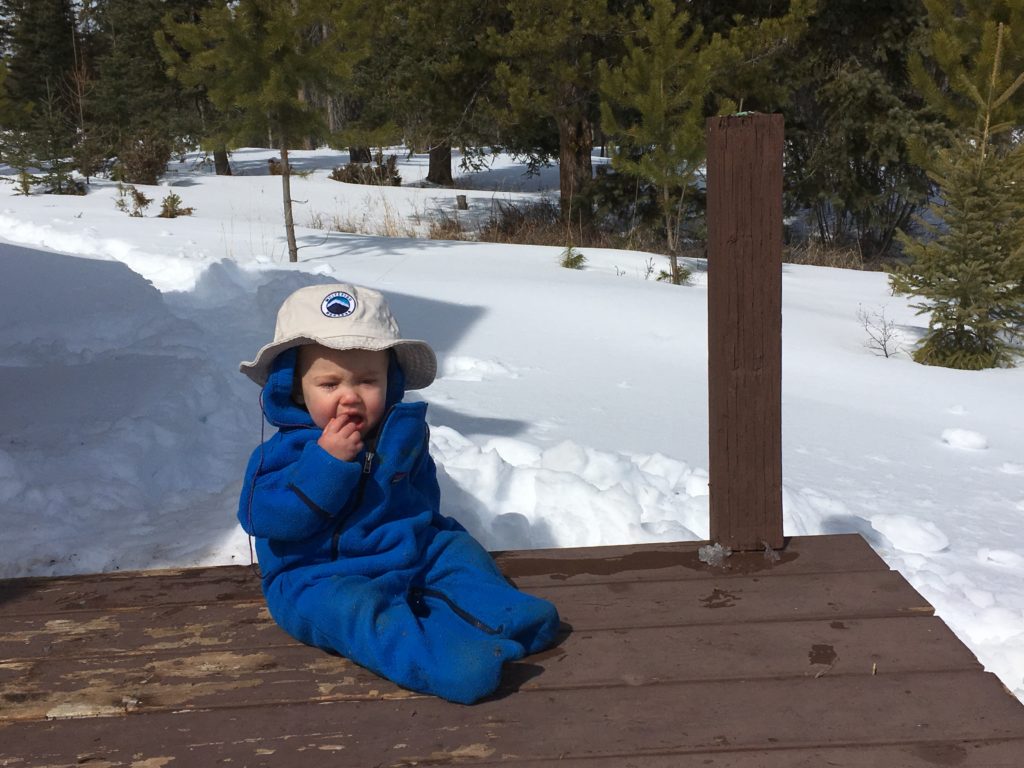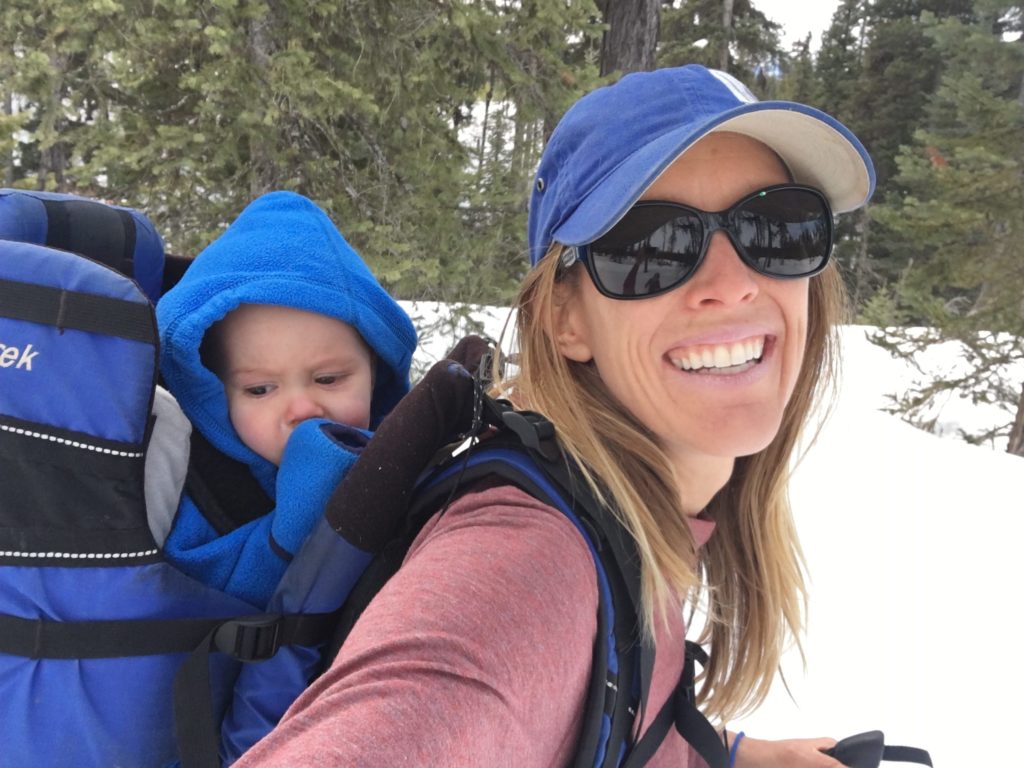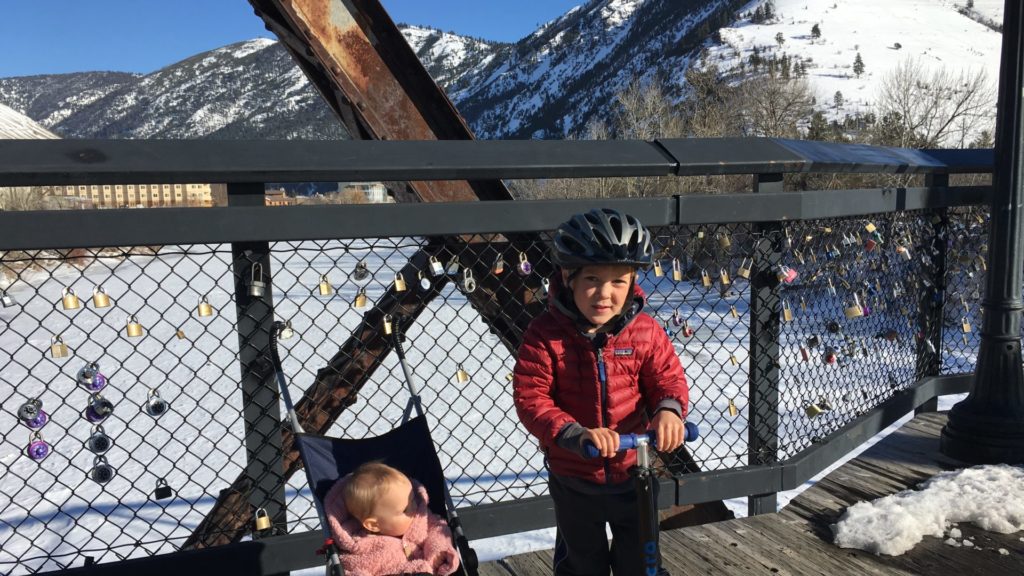Braving nature with kids when conditions are less than ideal can be challenging. But the benefits are worth the hassle.
“Not again!” my four-year-old son cried as he tottered sideways onto the slushy spring snow, cross-country skis akimbo.
I planted my poles and took a deep breath, trying to summon patience as Talon wailed out his frustration. His nine-month-old sister joined the screaming chorus from the trailer strapped around my husband’s waist.
Teaching kids winter sports is my least favorite parenting task—probably because winter is my least favorite season, even though I live in Montana. I usually manage to stay positive about winter through the holidays, when it’s still novel to cozy up and watch the snow fall.
By March, though, it’s pretty dang hard to muster enthusiasm for the umpteenth visit to the sledding hill or ice rink.

This year spring has been extra slow in shining through the cold across much of the northern U.S. We’ve got a three-foot berm of dirty snow piled alongside the driveway and playgrounds still coated in melting ice and mud—which makes getting outside with tiny tots challenging.
But the only thing worse than going outside when it’s slushy and slick is staying inside all day with two energetic little kids. My worst moments as a mom inevitably arise after we’ve all been cooped up too long.
That’s why Rob and I had loaded cross-country skis, sleeping bags, and piles of coats into our truck last Saturday morning. The weather forecast called for bright sun and above-freezing temps, so we decided to combat cabin fever with an overnight outing to a friend’s rustic cabin an hour north of Missoula.
After Talon’s fourth meltdown in ten minutes, though, I almost threw up my hands and yelled that we should just go home. Almost.
Instead I took a deep breath. I inhaled the scent of warm pine, lifted my face to the sun, and heard the melody of the creek. Calmer, I squatted to pick up my son, offering him a few gummy bears for being brave and trying something new. It worked like a charm.

Twenty minutes (and two more gummies) later, we made it to a small bridge over the creek where we stopped to have a picnic. Craggy mountains jutted up against the neon blue sky. Birds chirped in a glade beside the creek, picking at the just-budding leaves.
The baby was finally asleep, lulled by the rhythm of swishing skis. Talon, proud as a peacock to have made it on his own, scampered over to have “boat races” with his dad.
As they tossed sticks into the water, I stretched in the sunshine munching on a granola bar, grateful for the quiet and for the view. And grateful, most of all, to have pushed through the not-so-fun parts of packing, gearing up, and coaxing kids forward so that we could all arrive at this stunning spot.
Getting into nature with young children can be challenging, to say the least. Like me, many parents feel overwhelmed by the logistics or perceived risks of venturing outside with their children. Especially when conditions are less than ideal.
But the benefits are usually worth the hassle.

Our family is happier when we play outside and we bet yours will be, too:
1. Several studies have proven that being in nature relieves stress, increases creativity, and encourages kindness and generosity.
2. Adventures outside—whether its walking or skiing, birdwatching or canoeing—help kids problem-solve and learn new skills, while also supporting emotional and physical well-being for the whole family.
3. Finding fun in the fresh air draws kids away from screens that narrow their focus, minimizing nature-deficit disorder. It helps them connect with the people around them as well as recognize that we share this special planet with many other critters.
4. Outdoor activities are often inexpensive (or even free!) ways for kids to bond with their family and friends. It’s easy to locate used recreational gear if you’re interested in learning a new activity, or to simply enjoy public trails, ponds, or parks on your own two feet.

Here are a few tips for taking young kids outside this spring:
1. Pack snacks (and then pack more snacks).
Not only does food fuel the body and prevent meltdowns, it can act as a handy incentive for motivating kids to make the distance. Bars, nuts, jerky, and dried fruit are easy to stuff in pockets or backpacks. Consider bringing a special sweet treat to reward your kids at the end of the adventure.
2. Start small.
Don’t expect to scale the whole mountain on your first spring outing, or bike laps around the block when your kids (and you!) haven’t ridden in months. Set a realistic goal for your distance, destination, or time outside—and then cut it in half. This creates room to notice improvement as the season goes on.
3. Straight lines are boring.
While adults like to hike from Point A to Point B, kids prefer to travel in loops and zig-zags. Rather than getting agitated about sticking to a trail or a plan, be content to explore in circles and follow their curiosity wherever it may lead—even if it’s only following the snowmelt down a gutter and into a storm drain. It may take longer (see #2), but it free-form adventuring results in a more relaxed and happy family outing.
4. Let them get wet, dirty, and cold.
Don’t try to avoid the mess when conditions are inclement—embrace them. Encourage kids to muck about in the mud and splash through the water, and join in yourself (it’s fun!). Prepare before you leave with the appropriate clothing: lots of layers if it’s cold, waterproof boots, rain pants over regular pants, a coat and gloves. If you don’t own this gear, a plastic bag works just as well pulled up over shoes and tied around their legs. A garbage bag with a hole cut out for their head serves as a great poncho. Throw clothes in the laundry and kids in a bath when you get home.
5. Bring friends (for kids and adults).
It’s amazing how much more kids can accomplish when they have a buddy along. Peers provide children with friendly competition, distraction during tough spots, and double the fun. Same goes for parents—more hands make lighter work and louder laughter.
6. Make it a game.
When the nagging and whining start to escalate, change the focus into make-believe activities or short competitions. Race to the next rock by skipping or hopping. Pretend you’re on a ship in search of the next deep puddle to sail across. Play hide-and-seek in the trees as if you’re a lion stalking deer.
7. Try something new to everyone.
It helps diffuse mounting frustration if kids see that their parents mess up, too. They laugh in relief when we also fall down or trip or drop a canoe paddle. Plus, kids learn how to deal with their emotions by watching how we handle our own. Find an activity for your family that makes everyone feel a tad uncomfortable or awkward. Then try using humor as you make mistakes together.
Did you like this story? Scroll down to sign up for our newsletter!

